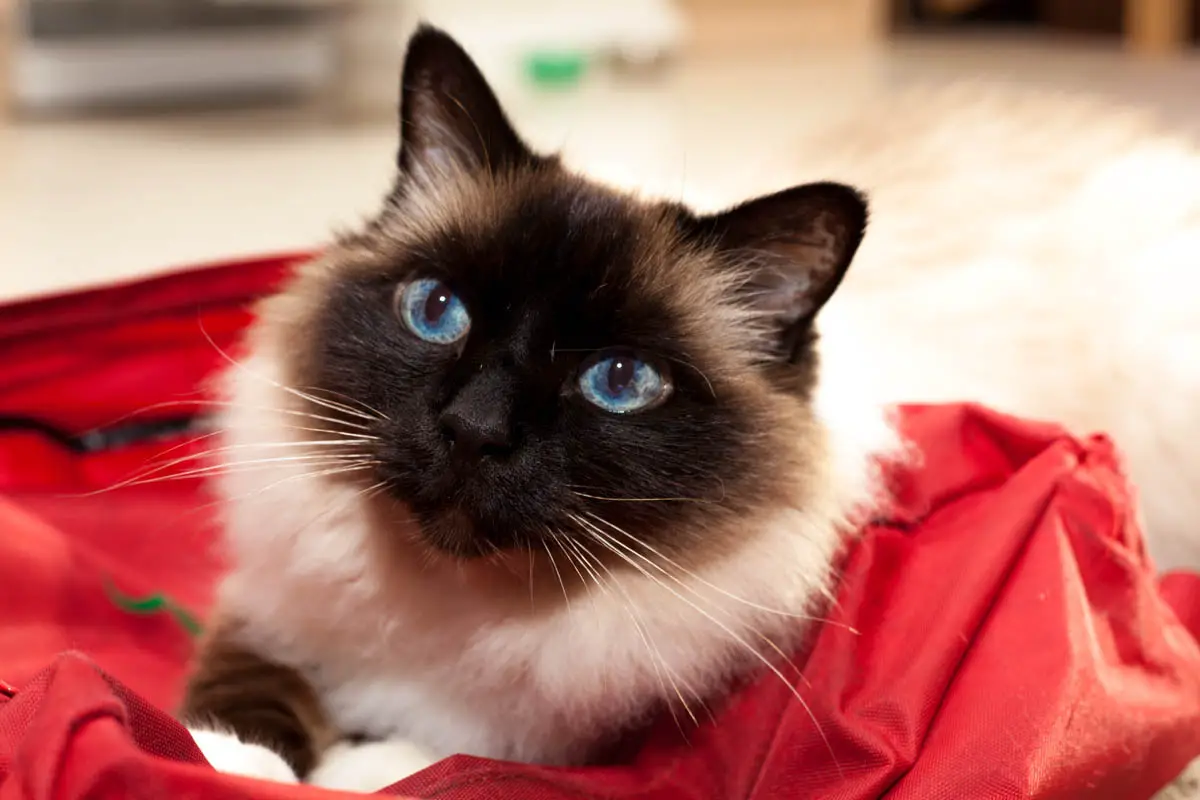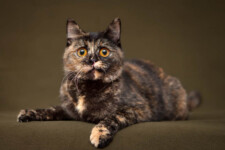Birman Cat Colors & Variations You Should Know
Birman cats, also called the Sacred Cats of Burma, are beautiful felines with roots in Buddhist stories.
This elegant and domestic cat breed comes in various colors, patterns, and variations.
If you are interested in Birman breeds or getting your own Birman cat, this guide will help you distinguish between their many coat options.

The Colorful Variations of Birman Cats
Blue Point Birmans
When most people think of Birman cats, they usually envision a Seal Point or Blue Point Birman. While they have their similarities, Blue Point Birmans have “blue” markings instead.
As most of us know, there is no such thing as actually and naturally blue cats; this blue refers to a special shade of grey.
Seal Point Birmans
Seal Point Birmans are the most classic Birman variation. These cats have a golden cream or beige base coat with dark brown markings, gradually fading to a lighter color on the underside.
These markings are found around the paws, face, and ears. They are called Seal Point Birmans because the marking color is a dark brown similar to the color of a seal.
Lilac Point Birmans
As a less common Birman cat variation, Lilac Points have special colors which make this type of Birman stand out. The point markings are a pinkish-grey that fades into a pale or white base coat.
Chocolate Point Birmans
Chocolate Point Birmans host an ivory-colored base coat. This base is intense, creating the perfect backdrop for its deep chocolate brown markings.
Its point pattern is similar to that of the Blue and Seal Point Birmans, but the overall look is distinctive due to its color combination.
Smokey Birmans
Smokey Birmans are cats with a silver-colored coat. The name gives them a more mysterious or dangerous connotation, but smoke-colored Birmans are just as relaxed as their differently-colored counterparts.
Smokey Birmans are unique to the other patterns, however, because of their smoke-on-smoke pattern. The points on this type of Birman are a darker silver on a lighter silver background.
Silver Tabby Birmans
This Birman is a special type of tabby cat. Tabby cats are typically grey or brown with a streaked or striped coat.
Silver Tabby Birmans have similarities to smokey Birmans, especially in their silver color; however, they have tabby markings, typically on their legs and head, which make them a sight to behold.
Cream Point Birmans
Cream Point Birmans have a delicate and subtle point pattern. Sometimes the markings aren’t even visible unless the base coast is paler or on the white side.
This type of Birman gets its name from the light coffee cream color of its points against a beige or golden base coat.
Tortoiseshell Birmans
Much like an actual tortoiseshell, Tortoiseshell Birmans combine colors spotted together to create a unique design. These are sometimes called “tortie” patterned Birmans.
These cats usually come in a mix of 3-4 colors with bases of either ivory or gold. Their points can be blue, seal, black, or chocolate coloring.
Torti Birmans can only be female, due to a genetic mix.
Some tortie variations include Seal Tortie, Blue Tortie, Chocolate Tortie, and Lilac Tortie.
Red Point Birmans
Red Point Birmans offer a special look with their bright reddish-gold points. On some Red Point Birmans, these points even seem to fade into an orange color.
The pale base coat makes a great background to highlight the points on a Red Point Birman, and some even show tabby features and markings.
Tabby Birmans
Tabby Birmans are a catch-all for the many colors we mention here. They may also be called Lynx Birmans.
While they can come in any of the colors, their pattern is distinct. Tabby Birmans have a distinct “M” pattern on their forehead, as well as other typical tabby cat markings. These markings can be stripes, whirls, spots, or other markings.
Tortie Tabby Birmans
Tortie Tabby Birmans are also only female. They carry both the Tortoiseshell and Tabby Birman genes, offering a great selection of possible colors.
All About Birman Cat Coats
All Birman cats are color-pointed, which means they have a darker color around the points of their bodies. These are called markings and are usually around their face, ears, legs, and tails.
All Birman cats are known for their markings, although some have much more prominent markings than others.
They have silky, medium-length coats that require weekly grooming and care. Its coat forms a heavy ruff around its neck and has waves on its underside. Their tails tend to be bushy and medium-length.
Birmans are usually born completely white or a very light color, slowly developing their colored markings as they get older.
Full markings usually develop by 18 months of age, but this depends on their base coat and genetic color intensity.
Birman Leg and Foot Markings
Most Birman Cats also have “gloves”, or all white feet that make the cat appear like it is wearing socks or boots. These may also be called gauntlets.
The most sought-after Birman cats have symmetrical gloves on all four legs, although this symmetry is not the easiest to find.
On the back paws of Birman cats, the gloves extend up the back of the leg, called “laces”.
These laces then end in an inverted-V shape on the tops of the cat’s hind legs. The more symmetrical the gloves and laces, the more likely the Birman can compete in the show ring.
Matting and Shedding
Birman coats are less likely to mat than Himalayan or Persian cats, but they should still be tended to regularly.
Birmans experience moderate shedding and may cause allergic reactions in some individuals. Springtime causes them to shed more heavily, and regular grooming is a must at this time.
Birman Cat Physical Features
Birman Cat eyes are round and deep blue. Resting above their cheekbones and above a Roman-shaped nose, these blue eyes are one of the Birman cat’s most identifying features.
Birman cats have stocky bodies and shorter legs. Their muscular bodies are quite distinct from Siamese or Persian cats.
Although strong in appearance, Birman Cats are well-known for their easy-going personalities. They tend to be confident, inquisitive, and playful within limits. You’ll be impressed by a Birman cat’s intelligence.
Owners of Birman cats find them to be affectionate and friendly, offering a kind demeanor to those around them, making them a good choice for a family with young children.
Birman cats are not as vocal as many other cats. They are also on the quieter side, with soft voices. You may be greeter with a soft meow upon arrival, but you’ll rarely hear a Birman cat wailing away in the night.
How Large Are Birman Cats?
These cats reach an adult size of approximately 15 to 18 inches and weigh between 6-12 pounds. Birman cat owners can enjoy their cozy pets for 12-16 years on average.
Birmans appreciate companionship with their owners and exhibit trust with those they are familiar with. Many families with children and cat-friendly dogs look to the Birman cat as a friendly addition to the family.
Most Common Birman Cats
After WWII, the world almost lost Birman cats as domestic pets. Luckily, they have since rebounded in numbers and many Birman cats are now commonly seen as household pets.
Seal Birman cats are the most common, with Blue Point Birmans coming in second.
These cats are found in most Birman breeders but, being that Birmans are a luxurious type of cat, even the most common ones can cost hundreds of dollars from a breeder.
What Are the Rarest Birman Cats?
There are a few Birman cat types that are much more difficult to find compared to Seal Point or Blue Point Birmans.
Silver Tabby and Cream Point Birmans are both rarer and more expensive. Few breeders focus on these types of Birmans, leading to their rarity.
Lilac Point Birmans are another one of the rarer patterns of Birmans, due to the recessive genes required to create the pattern.
Tortie Tabbies join this group, as they require a specific set of genes to be inherited for this female-only color to appear.
Most Popular Birman Cats
All Birman cats are known for their beautiful coats, dazzling eyes, and enjoyable personalities, which means that they’re a popular cat breed all-around.
The most popular Birman cat colors are typically Blue Point Birmans, although individual preference depends on a myriad of factors.
Birman breeders can charge anywhere from $400-$1000+ for a pure-bred Birman kitten, and the coat and color variation will play a large part in which types of Birmans are sold most often.
Birman Cat History (What We Do Know)
While its origin cannot be historically verified, most believe that Birman cats originated in the country of Burma, now called Myanmar. It was thought to be the sacred companion of temple priests on the Mount of Lugh in Burma.
The most popular story is that a pair of cats were given to Frenchmen as a gift for helping a temple and the priests inside. These cats were then taken back to France. There they were named after the French word Birmanie, which translates to Burma.
The earliest Birman cats were recorded to be in France in the early 1920s. Unfortunately, after WWII Birmans were almost extinct.
After being outcrossed with Persians and Siamese cats to rebuild the breed, Birman litters have since reproduced to become companions once more for cat owners across the globe.




